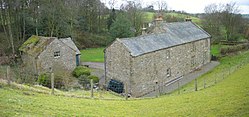Clockey Mill: Difference between revisions
Created page with "{{Infobox building |name=Clockey Mill |county=Cumberland |picture=Clockey Mill.jpg |picture caption=Clockley Mill, on the Mill Beck, Cumberland |os grid ref=NY583669 |latitude..." |
|||
| Line 30: | Line 30: | ||
The cart shed with a pitched roof, has a single ground floor window with a 6-pane casement and a centrally placed first floor loading door with boarded wooden door. | The cart shed with a pitched roof, has a single ground floor window with a 6-pane casement and a centrally placed first floor loading door with boarded wooden door. | ||
A cobbled | A cobbled yard lies at the entrance to the cartshed and the mill building. | ||
The water wheel has not survived, though the wheel spindle and hub remain, with the rotted remains of some of the spokes projecting for it. This was an overshot wheel, fed from the east by a water chute, of which the metal fixings remain if not the chute itself. | The water wheel has not survived, though the wheel spindle and hub remain, with the rotted remains of some of the spokes projecting for it. This was an overshot wheel, fed from the east by a water chute, of which the metal fixings remain if not the chute itself. | ||
Latest revision as of 12:14, 25 July 2017
| Clockey Mill | |
|
Cumberland | |
|---|---|
 Clockley Mill, on the Mill Beck, Cumberland | |
| Type: | Watermill |
| Location | |
| Grid reference: | NY583669 |
| Location: | 54°59’42"N, 2°39’11"W |
| History | |
| Built Early 18th century | |
| Watermill | |
| Information | |
Clockey Mill is an early eighteenth centuy watermill on the Mill Beck, a tributary stream of the King Water in eastern Cumberland, in the Parish of Kingwater.
The mill is in remarkable condition for its age and back-woods location, and is Grade II listed as 'a good example of a small C18 rural water mill' in a vernacular style 'well executed with good use made of local materials'.[1]
Structure
The mill is a small-scale mill grinding corn for a rural community of scattered hamlets and so is not built in any luxurious fashion but has survived well nevertheless. It is cruck-built, an ancient timber building pattern, and it is noted that 'the survival of the crudely constructed and intact upper cruck roof structure is an important feature'.[1] The mill was extended in the 19th century, but the original plan form of the mill as built is intact and readable, such that the original milling process can be read in the building to show the operation of a small-scale watermill.
The milling machinery has survived too, which is rare.
The mill is built of roughly coursed sandstone rubble with dressed sandstone quoins under stone slates (with some asbestos patching). The roof is a cruck construction, and has a modern slate roof. The original plan was of a rectangular building, but the later extension gives an L-shaped plan form, with an external wheel pit to the south-west and a later rectangular extension to the north west.
The cart shed with a pitched roof, has a single ground floor window with a 6-pane casement and a centrally placed first floor loading door with boarded wooden door.
A cobbled yard lies at the entrance to the cartshed and the mill building.
The water wheel has not survived, though the wheel spindle and hub remain, with the rotted remains of some of the spokes projecting for it. This was an overshot wheel, fed from the east by a water chute, of which the metal fixings remain if not the chute itself.
Historical records
Clockey Mill is mentioned in two rentals dated 1704 and 1714, which record the transfer of the mill from the Right Hon. Charles Earl of Carlisle to first George Foroster and then John Routledge, Yeoman. The latter document refers to the `Water Grist Mill' at Clockey with its houses, buildings, dams, wears and ponds. The First Ordnance Survey map of the area published in 1895 shows that the original rectangular mill building had been extended to the west by this time, which probably occurred in the mid 19th century when the present house was built.
The mill is thought to have continued in use into the early years of the 20th century and in its latter years it housed a hydro-electric generator.
Outside links
References
- ↑ 1.0 1.1 National Heritage List 1392495: Clockey Mill
- Clockey Mill - British Listed Buildings
- Harrison, J: 'The Rise of the White Loaf', (Society for the Protection of Ancient Buildings, Mills Section, 2005)